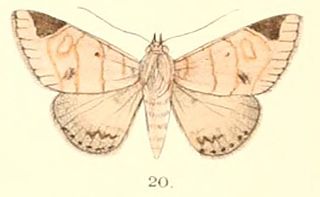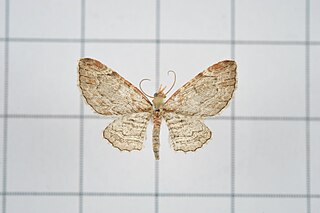
Dordura is a monotypic moth genus of the family Noctuidae erected by Frederic Moore in 1882. Its only species, Dordura aliena, was first described by Francis Walker in 1865. It is found in the Indian subregion, Sri Lanka, Myanmar, Thailand, Peninsular Malaysia, Sumatra, Borneo and New Guinea.

Psimada is a monotypic moth genus of the family Noctuidae. Its only species, Psimada quadripennis, is found in the Indian subregion, southern China, Taiwan, Myanmar, Thailand, Sri Lanka, the Andaman Islands, Sundaland, Sulawesi and Seram. Both the genus and species were first described by Francis Walker in 1858.

Ctenoplusia limbirena, the Scar Bank gem, or silver U-tail, is a moth of the family Noctuidae. It is found in south-western Europe, Africa, the Canary Islands, Arabia, the southern Himalayas, India, Sri Lanka, Indochina to south-eastern China, Taiwan, Sulawesi, Bali and Timor. In New Zealand, it has been established since 2011.

Stauropus alternus, the lobster caterpillar, lobster moth or crab caterpillar, is a moth of the family Notodontidae. It is found in the north-eastern Himalaya, Sri Lanka, Sundaland, the Philippines, Sulawesi and the southern Moluccas. It was described by Francis Walker in 1855.

Apona caschmirensis is a moth of the family Eupterotidae first described by Vincenz Kollar in 1844. It is found in Nepal, Pakistan and India.

Orgyia postica, the cocoa tussock moth or hevea tussock moth, is a species of moth of the subfamily Lymantriinae of the family Erebidae found in the Oriental tropics of India, Sri Lanka, Myanmar, Borneo, Java, New Guinea, and Taiwan. It was described by Francis Walker in 1855.

Gesonia obeditalis is a species of moth of the family Noctuidae first described by Francis Walker in 1859. It is found from eastern Africa, the Seychelles, the Maldives and the Oriental tropics of India, Myanmar, Sri Lanka east to the Philippines, the Sula Islands and Australia. The adult moth has brown wings with a scalloped dark brown band near the margin. The hindwings are similar in pattern to the forewings but are a paler shade of brown.

Scopula fibulata is a moth of the family Geometridae first described by Achille Guenée in 1858. It is found in Kenya, Sri Lanka and China.

Somera viridifusca, the prominent moth, is a moth of the family Notodontidae described by Francis Walker in 1855. It is found in Sri Lanka, Sundaland, the Philippines, Sulawesi, the north-eastern Himalayas, Sikkim in India, Hainan and Yunnan in China and in Taiwan.

Eupithecia costalis is a moth in the family Geometridae first described by Francis Walker in 1863. It is widespread in the tropical and subtropical lowland regions of east and south-east Asia, from Taiwan to India, Sri Lanka Borneo, to Hong Kong.
Collix hypospilata is a moth in the family Geometridae. It was described by Achille Guenée in 1857. It is endemic to Sri Lanka.
Gymnoscelis deleta is a moth in the family Geometridae. It is found in India, Korea, Japan, Taiwan and probably in Sri Lanka according to Hampson.
Iambia thwaitesii is a moth of the family Noctuidae first described by Frederic Moore in 1885.
Racotis boarmiaria is a species of moth of the family Geometridae described by Achille Guenée in 1857. It is found in India, Sri Lanka, Maldives, Myanmar, China, Japan, Taiwan, Indonesia, Bhutan and Malaysia.
Phalacra vidhisara is a moth in the family Drepanidae. It was described by Francis Walker in 1860. It is found in Sri Lanka and India.
Pandala is a monotypic moth genus in the family Eupterotidae described by Francis Walker in 1855. Its single species, Pandala dolosa, described by the same author in the same year, is found in Sri Lanka.
Eupterote testacea is a moth in the family Eupterotidae. It was described by Francis Walker in 1855. It is found in India and Myanmar.
Eupterote acesta is a moth in the family Eupterotidae. It was described by Charles Swinhoe in 1894. It is found in Thailand and India.
Eupterote translata is a moth in the family Eupterotidae. It was described by Charles Swinhoe in 1885. It is found in India.
Eupterote patula is a moth in the family Eupterotidae. It was described by Francis Walker in 1855. It is found in Thailand, Myanmar and India.









